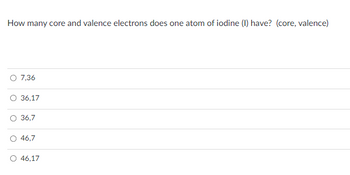
Chemistry
10th Edition
ISBN: 9781305957404
Author: Steven S. Zumdahl, Susan A. Zumdahl, Donald J. DeCoste
Publisher: Cengage Learning
expand_more
expand_more
format_list_bulleted
Concept explainers
Question

Transcribed Image Text:**Question:**
How many core and valence electrons does one atom of iodine (I) have? (core, valence)
**Answer Choices:**
- ○ 7,36
- ○ 36,17
- ○ 36,7
- ○ 46,7
- ○ 46,17
*Note: This question appears to test knowledge in chemistry, specifically electron configuration and the distinction between core and valence electrons in an iodine atom.*
Expert Solution
This question has been solved!
Explore an expertly crafted, step-by-step solution for a thorough understanding of key concepts.
This is a popular solution
Trending nowThis is a popular solution!
Step by stepSolved in 3 steps

Knowledge Booster
Learn more about
Need a deep-dive on the concept behind this application? Look no further. Learn more about this topic, chemistry and related others by exploring similar questions and additional content below.Similar questions
- Determine the amount of energy lost by an electron that drops from the eight (n=8) to the first energy level (n=1) in a hydrogen atom. 2.15 x 10-18 J 2.08 x 10-19 J 2.97 x 10-20 J 9.14 x 10-18 Jarrow_forward00 Il Kr has 36 protons and 36 electrons. Give the symbol of two anions and two cations that are isoelectronic (same number of electrons) with Kr. 自 8:26 24 4 2. backspace ! } { d [ 4 k %3D enter shift alt ctrl (intel) ENERGY STAR insidearrow_forward9% ר ווקרווווונסון רבמן9 Name the element in the second period of the periodic table with 5 valence electrons. element name: element name: Name the element in the second period of the periodic table with six 2p electrons. Phosphorus element name: Name the element in the fourth period of the periodic table with two 4p electrons. Carbon element name: Resources Germanium Name the element in the fifth period of the periodic table with 6 valence electrons. Tellurium I Lx Give Up?arrow_forward
- Using only the periodic table, arrange the following elements in order of increasing atomic radius: Neon, beryllium, oxygen, boron Smallest --> Largestarrow_forwardOrder the following elements from largest atomic radius to smallest? Group of answer choices Ca > Ga > Se > Kr Kr > Se > Ga > Ca Ga > Ca > Se > Kr Kr > Ca > Ga > Searrow_forward58 Ce 90 Th silicon magnesium phosphorus Submit Answer sulfur 59 60 Pr Nd 61 Pm Sm 62 63 64 65 Tb Retry Entire Group Eu Gd 91 92 93 94 95 96 97 Pa U Np Pu Am Cm Bk [Review Topics] 67 68 Ho Er 85 80 66 Arrange the following elements in order of increasing metallic character: Dy 99 100 Cf Es Fm 98 LEAST Metallic Clear All Second LEAST Metallic Second MOST Metallic MOST Metallic Tm 101 Md 5 more group attempts remaining Yb 102 Noarrow_forward
- Rank the following elements in order of increasing atomic size: carbon, silicon, Florinearrow_forwardHow many valence electrons do the atoms in the circled column have? Hydrogen Neme 1.000 Weight 2 Li Lithium 8.94 11 3 Na Sodium 22.990 19 4 K 37 5 Rb Rubidium 85.465 66 6 Cs Costum 132.91 87 7 Fr Plum Calum 39.090 80076 O O O O O 8 6 88 Ra Franckum Radium (223) (225) 17 2 Atomic Symbol 3 1 4 Be 5 Baryum 9.0122 12 Mg M 24.305 20 Ca 56 Ba Baum 13733 3 38 Sr Strontium trium 38.906 39 Y C Solid Hg Liquid H Gas 21 22 Sc Ti 44.955 Scandium Tanum 47.967 Rf Unknown 40 Zr Zirconium 21.224 72 57-71 Hf Halum 171.49 104 89-103 Rf 10 Raw (267) 41 Nb Nisblum 22.208 6 7 8 9 73 Ta Tentalum 160 95 Alkali metals metals Alkaline earth 24 Cr 23 25 26 Mn Fe V Vanadium Chronun Magese Iron 50.947 $1.936 $4.530 55.345 74 W Tungsten 183.34 Metala Lanthanoids 76 Re Actinoids 42 43 45 Mo TC Ru Rh Volbdenum Technetium Ruthenium Rhodium 25.99 (58) 102.01 101.07 76 Os Orien 19:23 henken 105.31 107 Bh 106 106 Db Sg Dubnium San Rohrian Hvodum (2.701 (277) (258) 1280 108 Hs Transition metal 27 Co Cobalt 77 Ir vidun…arrow_forwardThe first four ionization energies (IE) for an atom are given below. What is the identity of this atom? IE₁ = 738 kJ/mol IE₂ = = 1451 kJ/mol IE3 = 7733 kJ/mol IE4 = 10,542 kJ/molarrow_forward
arrow_back_ios
arrow_forward_ios
Recommended textbooks for you
 ChemistryChemistryISBN:9781305957404Author:Steven S. Zumdahl, Susan A. Zumdahl, Donald J. DeCostePublisher:Cengage Learning
ChemistryChemistryISBN:9781305957404Author:Steven S. Zumdahl, Susan A. Zumdahl, Donald J. DeCostePublisher:Cengage Learning ChemistryChemistryISBN:9781259911156Author:Raymond Chang Dr., Jason Overby ProfessorPublisher:McGraw-Hill Education
ChemistryChemistryISBN:9781259911156Author:Raymond Chang Dr., Jason Overby ProfessorPublisher:McGraw-Hill Education Principles of Instrumental AnalysisChemistryISBN:9781305577213Author:Douglas A. Skoog, F. James Holler, Stanley R. CrouchPublisher:Cengage Learning
Principles of Instrumental AnalysisChemistryISBN:9781305577213Author:Douglas A. Skoog, F. James Holler, Stanley R. CrouchPublisher:Cengage Learning Organic ChemistryChemistryISBN:9780078021558Author:Janice Gorzynski Smith Dr.Publisher:McGraw-Hill Education
Organic ChemistryChemistryISBN:9780078021558Author:Janice Gorzynski Smith Dr.Publisher:McGraw-Hill Education Chemistry: Principles and ReactionsChemistryISBN:9781305079373Author:William L. Masterton, Cecile N. HurleyPublisher:Cengage Learning
Chemistry: Principles and ReactionsChemistryISBN:9781305079373Author:William L. Masterton, Cecile N. HurleyPublisher:Cengage Learning Elementary Principles of Chemical Processes, Bind...ChemistryISBN:9781118431221Author:Richard M. Felder, Ronald W. Rousseau, Lisa G. BullardPublisher:WILEY
Elementary Principles of Chemical Processes, Bind...ChemistryISBN:9781118431221Author:Richard M. Felder, Ronald W. Rousseau, Lisa G. BullardPublisher:WILEY

Chemistry
Chemistry
ISBN:9781305957404
Author:Steven S. Zumdahl, Susan A. Zumdahl, Donald J. DeCoste
Publisher:Cengage Learning

Chemistry
Chemistry
ISBN:9781259911156
Author:Raymond Chang Dr., Jason Overby Professor
Publisher:McGraw-Hill Education

Principles of Instrumental Analysis
Chemistry
ISBN:9781305577213
Author:Douglas A. Skoog, F. James Holler, Stanley R. Crouch
Publisher:Cengage Learning

Organic Chemistry
Chemistry
ISBN:9780078021558
Author:Janice Gorzynski Smith Dr.
Publisher:McGraw-Hill Education

Chemistry: Principles and Reactions
Chemistry
ISBN:9781305079373
Author:William L. Masterton, Cecile N. Hurley
Publisher:Cengage Learning

Elementary Principles of Chemical Processes, Bind...
Chemistry
ISBN:9781118431221
Author:Richard M. Felder, Ronald W. Rousseau, Lisa G. Bullard
Publisher:WILEY